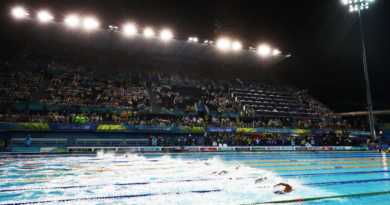USWNT's rich World Cup history with penalties: 'The emotion of the moment'
AUCKLAND, New Zealand — The just-concluded group stage at the 2023 FIFA Women’s World Cup was arguably the most captivating in the tournament’s history, and surprises and chaos were the order of the day.
Presumed heavyweights Germany, Brazil and Canada failed to make it out of their respective groups. The two-time defending Women’s World Cup champions U.S. barely scraped by, saved by the post in its group stage finale against Portugal. Then there was the dramatic goal scored by South Africa’s Thembi Kgatlana against Italy that propelled Banyana Banyana to a 3-2 victory and into the knockout rounds at the Italians’ expense. Jamaica’s master class in defending also saw it emerge from the group stage for the first time in its history.
– Women’s World Cup: Landing page | Schedule | Rosters | News
– Stream on ESPN+: LaLiga, Bundesliga, more (U.S.)
But now a different kind of drama awaits, that being the knockout stages: win or go home. And there’s always the possibility that the sport’s ultimate shot of adrenaline, the penalty shootout, might make an appearance. Odds are that spot kicks will decide at least one match in this tournament, too: you’d have to go back to 2007 to find the last time a Women’s World Cup didn’t have a penalty shootout.
In a sport filled with clashes and individual battles, a penalty kick is soccer’s ultimate duel. In an age where just about every professional game can be scouted and data compiled, there aren’t many secrets in terms of a shooter’s preferences and a goalkeeper’s history in stopping penalties. So what commences instead is a “Princess Bride”-style battle of wits.
The goalkeeper knows which way the shooter has gone in the past, so she’ll react accordingly. But the shooter knows that the goalkeeper knows and so she’ll maybe do something different. And yet, the goalkeeper knows that the shooter knows that the goalkeeper knows. The psychological mind games are, to borrow a term from the Dread Pirate Roberts, dizzying.
“I think a penalty is such a unique situation in the game of football,” said U.S. forward Alex Morgan. “It’s one that you can try to recreate in training, but obviously the psychological factor comes into play with a packed stadium, with a goalkeeper you might not have faced before, with the pressure of where you are in a game; if you’re up, you’re down or whatever the score line is. But at the same time, it’s something that you train and train and the ball is always at the same spot and you try to put it in a particular place.
The early part of this World Cup was notable for the number of penalties squandered — four of the first eight penalties awarded weren’t converted, including one by Morgan against Vietnam that was saved. But in the ensuing weeks, order has been restored. As of this writing, 17 of 22 penalties were converted, which comes out to 77.3% — right around the conversion rate of 76.9% for non-shootout penalties at the three previous Women’s World Cups (the only tournaments for which such stats were available).
All of that said, a penalty shootout adds another layer of intensity to the whole penalty-taker vs. goalkeeper clash. The stakes are immense. Momentum can disappear as soon as it arrives. The pressure is suffocating.
Former U.S. international forward Abby Wambach recalls her penalty shootout attempt in the epic quarterfinal against Brazil at the 2011 World Cup. She admits she wasn’t nearly as calm as she appeared.
“I was standing on the ball. I was standing at the penalty spot waiting to kick my penalty shot,” she told ESPN in an exclusive interview. “My face is like totally stoic. I’m totally capable. I’m ready. I’m willing to do this. But my statistical heart rate — because we’re all wearing monitors — was in the 90th percentile. It’s extremely hard to get your heart rate in the 90th percentile, especially for an elite athlete. Usually what it takes is like sprinting at level 10, at an incline of 10 for like minutes and minutes. That’s what it usually takes.
“The emotion of the moment just had me totally amped.”
Wambach converted and she was still fired up afterward, even giving some pointed instructions to Ali Krieger, who had a chance to win the game with her attempt.
“I just had started to walk and [Abby is] like, ‘No, you gotta like jog up there!’ And I’m like, ‘OK, OK, all right,'” said Krieger, who is contributing to ESPN’s coverage of the current tournament. “So I get up to the spot, and everything just was silent. It was me and the goal, and I didn’t think about anything else. I just put my head down and said ‘I need to try to hit this in the corner as hard as I can, and we go through.'”
Krieger was able to finish it off and the U.S. was on to the semifinals. Alas, the fickle nature of penalties came back to bite the Americans in the final against Japan: the U.S. missed three of its four attempts, and Japan prevailed.
1:02
Williams: The USWNT will be a scary thought when team clicks
Lynn Williams says the USWNT is embracing the pressure it faces at the World Cup.
Statistically, the penalty conversion rate in a shootout at the previous Women’s World Cups was 76.3% — about the same as in regulation — but in this scenario, goalkeepers do have some advantages beyond scouting. First, there are low expectations. The shooter is supposed to score. Then there is the repetitive nature of a shootout. Instead of the one-and-done nature of a regulation penalty, keepers can get into more of a rhythm and get a read on the penalty takers.
Yes, like an opposition poker player, there are tells. Former U.S. international goalkeeper Briana Scurry said her coach at UMass-Amherst, Jim Rudy, taught her how to play percentages based on the angle of the shooter’s approach, the distance from the ball of the plant foot, left or right foot and if/when the hips opened prior to the ball being struck. When she got to the national team, Tony DiCicco — who was a goalkeeper in his playing days — emphasized the same tendencies.
“[DiCicco] felt I shouldn’t guess, but said if I had a gut feeling — which I don’t consider a guess — then I could go with that,” Scurry told ESPN in an exclusive interview.
A combination of gut feel as well as tells came to the fore in the now-legendary penalty shootout against China in the 1999 Women’s World Cup final. Scurry recalls how she had a routine that she followed religiously: when a teammate was shooting, she would turn her back to the field and wait for the crowd reaction to tell her what happened.
“I didn’t put anything in my mind that I couldn’t do anything about,” she said.
When it was her turn, she would pace back and forth on the goal line and get set, all without looking at the kicker. But when Liu Ying stepped up to take China’s third attempt, Scurry broke with her routine.
“Something in my mind said, ‘Look at that third kicker for China,'” Scurry said. “I knew right when I looked at her that I was going to save that one before I even went in the goal. Her shoulders were sloped. She just didn’t seem very confident. Knowing what I know about PKs, her hips were so open. You could totally tell, if you knew what you were looking at, that it was savable.
“She didn’t strike it overly hard. It was at the goalkeeper’s knee-to-hip height, which is the exact wrong place for a kicker to kick the ball. That’s the goalkeeper’s sweet spot to me. And that’s exactly where she kicked it. And so I came off the line, like I was taught to do, and made the save.”
As Scurry and her U.S. teammates showed that day, prevailing in a shootout is about staying composed and executing in that situation, regardless of what side of the duel a player is on. The coming weeks will reveal if more penalty shootout drama is in store.




